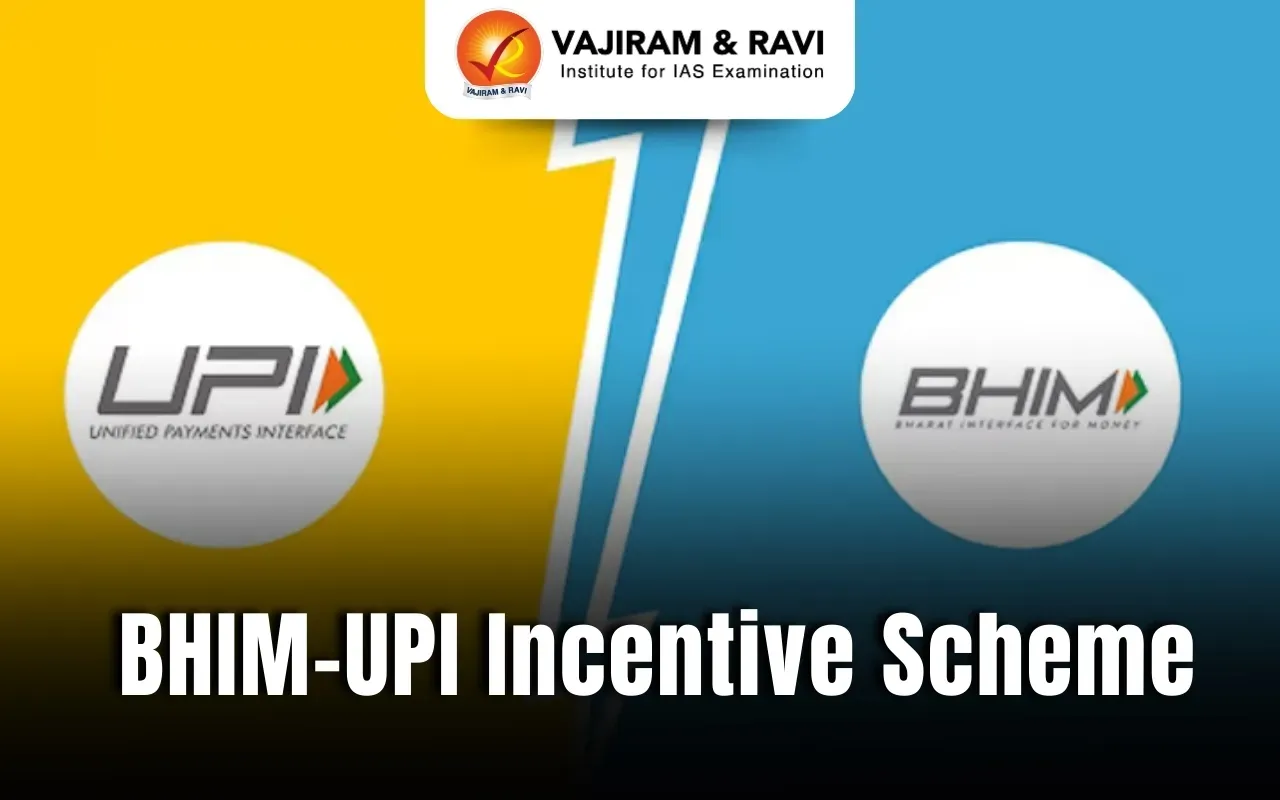What’s in Today’s Article?
- BHIM-UPI Incentive Scheme Latest News
- Bharat Interface for Money (BHIM)
- UPI Incentive of ₹1,500 Crore to Banks
- BHIM-UPI Incentive Scheme FAQs
BHIM-UPI Incentive Scheme Latest News
- The Union Cabinet chaired by the PM Modi approved the ‘Incentive Scheme for promotion of low-value BHIM-UPI transactions Person to Merchant (P2M)’ for the financial year 2024-25.
Bharat Interface for Money (BHIM)
- BHIM is a digital payment platform that enables fast, secure, and reliable transactions using the Unified Payments Interface (UPI) via a mobile app and *USSD (99#) service.
Launch and Adoption
- Launched by the Prime Minister on 30th December 2016.
- Achieved 1 crore downloads on Android Play Store and over 2 million transactions within 10 days.
Key Features
- Interoperability: Works seamlessly with other UPI applications and bank accounts.
- Developed by NPCI: Created under RBI’s guidance to enhance retail digital payments.
- User-Friendly Design: Offers quick onboarding, an intuitive interface, and seamless transactions.
Benefits for Merchants
- Enables direct bank account payments.
- Provides a Virtual Payment Address (VPA) and a QR code for easy transactions.
UPI Incentive of ₹1,500 Crore to Banks
- The Union cabinet has announced an incentive scheme for UPI payments of less than ₹2,000 for 2024–25 with an outlay of around ₹1,500 crore.
Background
- The Government promotes digital payments as part of its financial inclusion strategy while ensuring diverse payment options.
- The cost of digital transactions is covered through the Merchant Discount Rate (MDR), which is up to 0.90% for debit cards and up to 0.30% for UPI P2M transactions.
- MDR is the fee banks charge merchants for processing transactions.
- Since January 2020, MDR has been waived for RuPay Debit Cards and BHIM-UPI transactions via legal amendments.
- To support payment service providers, the Cabinet approved this incentive Scheme.
Aim of the Scheme
- The government aims to promote digital payments and increase BHIM-UPI transaction volumes to 200 billion in FY25.
- The incentive focuses on low-value peer-to-merchant (P2M) transactions to encourage small merchants.
Objectives of the Scheme
- Promote the indigenous BHIM-UPI platform.
- Achieve a transaction volume target of ₹20,000 crore in FY25.
- Strengthen digital payments infrastructure.
- Expand UPI penetration in rural and remote areas through solutions like UPI 123PAY (feature phone-based) and UPI Lite/UPI LiteX (offline payments).
- Maintain high system uptime and reduce technical failures.
Incentive Structure
- For transactions up to ₹2,000:
- Small merchants: 0.15% incentive.
- Large merchants: No incentive.
- For transactions above ₹2,000: No incentives for any merchant.
Benefits of the Scheme
- Enhances digital transactions’ convenience, security, and efficiency.
- Ensures zero additional charges for consumers and small merchants.
- Encourages UPI adoption among small merchants, aiding financial inclusion.
- Supports the government’s push for a less-cash economy.
- Ensures 24/7 availability of UPI services by incentivizing banks to maintain uptime and minimize technical failures.
- Balances UPI growth with minimal financial burden on the government.
Industry Concerns Over Insufficient Allocation
- The digital payment industry believes ₹1,500 crore is inadequate for sustaining UPI processing costs.
- Industry estimates suggest ₹4,000-₹5,000 crore is needed to support the ecosystem.
- Experts suggest introducing a controlled MDR (Merchant Discount Rate) of 0.25% for merchants with over ₹40 lakh turnover while keeping incentives for smaller merchants.
BHIM-UPI Incentive Scheme FAQs
Q1. What is the new BHIM-UPI incentive scheme?
Ans. The Indian government allocated ₹1,500 crore for incentivizing low-value BHIM-UPI transactions in FY25.
Q2. Who benefits from the BHIM-UPI incentive scheme?
Ans. Small merchants accepting transactions below ₹2,000 will receive incentives to promote digital payments.
Q3. Why was MDR waived for RuPay and BHIM-UPI?
Ans. To encourage digital payments, the government waived MDR on RuPay debit cards and BHIM-UPI transactions since 2020.
Q4. What is the government’s target for UPI transactions?
Ans. The goal is to reach 200 billion transactions and ₹20,000 crore transaction volume in FY25.
Q5. How does this scheme impact financial inclusion?
Ans. It expands UPI penetration in rural areas, strengthens the digital payments ecosystem, and enhances merchant adoption.
Last updated on December, 2025
→ Check out the latest UPSC Syllabus 2026 here.
→ Join Vajiram & Ravi’s Interview Guidance Programme for expert help to crack your final UPSC stage.
→ UPSC Mains Result 2025 is now out.
→ UPSC Notification 2026 is scheduled to be released on January 14, 2026.
→ UPSC Calendar 2026 is released on 15th May, 2025.
→ The UPSC Vacancy 2025 were released 1129, out of which 979 were for UPSC CSE and remaining 150 are for UPSC IFoS.
→ UPSC Prelims 2026 will be conducted on 24th May, 2026 & UPSC Mains 2026 will be conducted on 21st August 2026.
→ The UPSC Selection Process is of 3 stages-Prelims, Mains and Interview.
→ UPSC Result 2024 is released with latest UPSC Marksheet 2024. Check Now!
→ UPSC Prelims Result 2025 is out now for the CSE held on 25 May 2025.
→ UPSC Toppers List 2024 is released now. Shakti Dubey is UPSC AIR 1 2024 Topper.
→ UPSC Prelims Question Paper 2025 and Unofficial Prelims Answer Key 2025 are available now.
→ UPSC Mains Question Paper 2025 is out for Essay, GS 1, 2, 3 & GS 4.
→ UPSC Mains Indian Language Question Paper 2025 is now out.
→ UPSC Mains Optional Question Paper 2025 is now out.
→ Also check Best IAS Coaching in Delhi

















